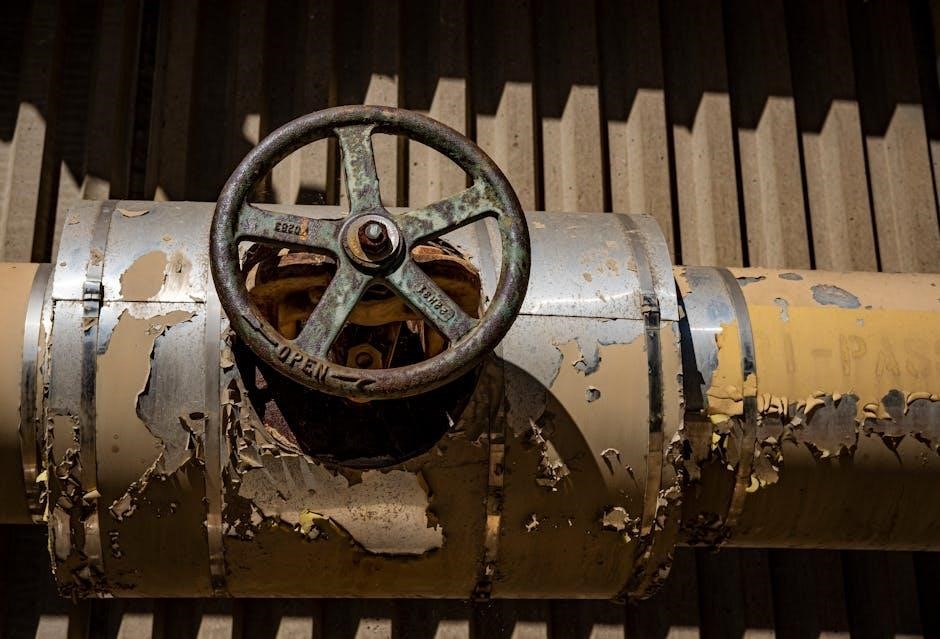Valve guides are critical components in an engine, playing a key role in maintaining proper valve operation. They are cylindrical components that align and support the valve stems, ensuring smooth movement within the engine. Typically made from durable materials like bronze or steel, valve guides are designed to withstand high temperatures and mechanical stress. Over time, however, they can wear out due to factors like excessive heat, oil contamination, or improper maintenance. Worn valve guides can lead to oil seeping into cylinders, causing issues such as white smoke from the exhaust and reduced engine performance. Regular maintenance and timely repairs are essential to prevent these problems and ensure optimal engine function.

Function and Design of Valve Guides
Valve guides are cylindrical components in an internal combustion engine that serve as the primary support for the valve stems. Their primary function is to ensure precise alignment and smooth movement of the valves as they open and close during engine operation. Properly functioning valve guides are essential for maintaining engine efficiency, performance, and longevity. They are typically located in the cylinder head and are designed to withstand the high temperatures and mechanical stresses generated by the engine.
The design of valve guides varies depending on the engine type and manufacturer, but they are generally made from durable materials such as bronze, steel, or cast iron. These materials are chosen for their strength, heat resistance, and ability to maintain dimensional stability under extreme conditions. The inner diameter of the valve guide is precisely machined to fit the valve stem snugly, ensuring minimal wear and tear over time. Some engines also feature replaceable valve guides, which can be serviced or replaced without requiring extensive cylinder head reconstruction.
Besides aligning the valves, valve guides also play a role in heat dissipation. They are often designed with cooling pathways or features that allow engine coolant to circulate around them, helping to regulate temperature and prevent overheating. Additionally, valve guides are responsible for maintaining the proper lubrication of the valve stem by allowing oil to flow through or around them. This ensures that the valve train operates smoothly and reduces the risk of premature wear.
The design of valve guides also incorporates features that minimize the risk of contamination. For example, they are typically sealed at the bottom to prevent debris or carbon buildup from entering the guide and causing damage. In modern engines, valve guides may also be coated with specialized materials to reduce friction and improve durability. These advancements in design have significantly improved the lifespan of valve guides, even in high-performance or heavy-duty applications.

Causes of Worn Valve Guides
Valve guides are subject to wear and tear due to various factors that affect their durability and performance. One of the primary causes of worn valve guides is excessive heat. Engines generate significant heat during operation, and if the cooling system is not functioning properly, the valve guides can overheat, leading to thermal expansion and wear. This is particularly common in engines with inadequate cooling pathways or those operated in extreme conditions.
Another major cause is improper lubrication. Valve guides rely on engine oil for lubrication to reduce friction between the valve stem and the guide. If the oil flow is insufficient or the oil is contaminated, the valve stem can wear down the guide over time. Contaminated oil, often caused by poor filtration or infrequent oil changes, can introduce abrasive particles that accelerate wear. Additionally, using the wrong type of oil or low-quality lubricants can exacerbate this issue.
High mileage and age are also significant contributors to worn valve guides. Over time, the constant up-and-down motion of the valve stem within the guide causes natural wear and tear. Engines with high mileage are more prone to this type of wear, as the repetitive motion over thousands of cycles can cause the guide to become loose or misaligned. This wear can be further compounded by aggressive driving habits, such as rapid acceleration or frequent high-RPM operation.
Oil consumption is another factor that can lead to worn valve guides. If the engine is burning excessive oil, it can seep into the cylinders through the guides, causing them to become coated with carbon deposits. These deposits can interfere with the proper seating of the valve, leading to further wear and potential damage to the engine. This issue is often exacerbated by worn piston rings or cylinder walls, which allow oil to enter the combustion chamber.
Symptoms of Worn Valve Guides
Worn valve guides can manifest through several noticeable symptoms that indicate potential issues with the engine. One of the most common signs is the presence of white smoke emanating from the exhaust. This smoke is caused by oil seeping into the combustion chamber through the worn guides and being burned along with the fuel. The oil, when burned, produces a visible white vapor that exits through the exhaust system.
Another symptom is increased oil consumption. As the valve guides wear out, they allow engine oil to enter the cylinders, where it is burned during combustion. This results in a noticeable decrease in oil levels, requiring more frequent refills. Over time, this can lead to premature wear on other engine components due to insufficient lubrication.
Engine misfires are also a common symptom of worn valve guides. When the guides are worn, the valve stem may not align properly, causing the valve to open or close incorrectly. This can disrupt the combustion process, leading to misfires and a rough-running engine; Drivers may notice a stumbling or hesitation sensation when accelerating.
In addition to these issues, worn valve guides can produce audible noises. A ticking or clattering sound from the engine, especially when cold, is often indicative of worn guides. This noise occurs as the valve stem moves loosely within the worn guide, creating a gap that allows the valve to strike the guide improperly during operation.
Finally, a decrease in overall engine performance can be a sign of worn valve guides. The inefficient combustion process caused by misaligned valves can lead to reduced power output, decreased fuel efficiency, and a general decline in engine responsiveness. These symptoms, when combined, should prompt a thorough inspection of the valve train to identify and address any issues with the guides.

Diagnosing Worn Valve Guides
Diagnosing worn valve guides requires a systematic approach to identify the problem accurately. One of the most effective methods is a visual inspection of the valve train. By removing the valve cover, a technician can examine the valve guides for signs of wear, such as excessive clearance between the guide and the valve stem, or visible scoring on the guide’s surface. Additionally, the presence of oil inside the guide indicates that oil is seeping past the valve seal, a common symptom of worn guides.
A leak-down test is another reliable diagnostic tool. This test involves pressurizing the cylinder and listening for escaping air, which can indicate where the leak is occurring. If air is heard coming from the oil fill cap or the exhaust, it suggests that the valve guide is allowing oil to enter the combustion chamber. Similarly, a compression test can reveal low compression in one or more cylinders, potentially pointing to worn valve guides as the culprit.
A technician may also perform a visual inspection of the spark plug. If the plug is fouled with oil, it can indicate that oil is entering the cylinder through the worn valve guide. Furthermore, excessive oil consumption, evidenced by frequent oil top-ups, is a strong sign of worn guides. In some cases, a boroscope can be used to inspect the guide without disassembling the engine, providing a clear view of the internal condition.
Another diagnostic method involves checking for unusual engine noises. A ticking or clattering sound, especially when the engine is cold, can indicate worn valve guides. This noise occurs as the valve stem moves loosely within the worn guide. By combining these diagnostic techniques, a technician can accurately determine if worn valve guides are the source of the problem and recommend the appropriate repairs.

Repair Options for Worn Valve Guides
When valve guides are worn, several repair options are available depending on the severity of the damage. The most common solution is to replace the worn valve guides with new ones. This involves removing the old guides and installing new ones, typically made from durable materials like bronze or steel. In some cases, the cylinder head may need to be removed and machined to ensure proper fitment of the new guides. This is a permanent fix and restores the valve train to optimal operation.
Another option is to install guide liners, which are thin, cylindrical sleeves inserted into the existing guides. This method is less invasive and can be done without removing the cylinder head, making it a cost-effective solution for minor wear. However, guide liners are only suitable if the original guides are not excessively damaged.
In cases where the guides are severely worn, reaming or honing the guides to accept oversized valve stems may be necessary. This process involves enlarging the guide bore to fit new, larger-diameter valve stems. While this can extend the life of the engine, it is considered a temporary fix and may not be as reliable as replacing the guides entirely.
For engines with particularly severe wear, it may be necessary to replace the entire cylinder head. This is a more expensive option but ensures that all components are in good condition. Additionally, some technicians recommend using specialized repair kits that include new guides, valve stem seals, and other components to restore the valve train to like-new condition.
Regardless of the method chosen, it is crucial to ensure that the repair is performed by a skilled technician using proper tools and techniques. Improper installation can lead to further damage or premature wear. In many cases, it is also advisable to replace the valves themselves, as worn guides can cause damage to the valve stems over time.
By addressing worn valve guides promptly and effectively, engine performance can be restored, and further damage to other components can be prevented. Regular maintenance and inspections are key to identifying and repairing worn guides before they lead to more serious issues.

Maintenance to Prevent Valve Guide Wear
Regular maintenance is essential to prevent valve guide wear and ensure the longevity of your engine. One of the most effective practices is to adhere to a consistent oil change schedule. Using high-quality motor oil that meets the manufacturer’s specifications helps lubricate moving parts, including valve stems and guides, reducing friction and wear. Additionally, keeping the engine clean and free from debris can prevent contaminants from accelerating guide wear.
Inspecting the valve stems and guides during routine maintenance is crucial. A technician can identify early signs of wear, such as excessive clearance or scoring, and address them before they become major issues. Replacing worn valve stem seals during these inspections can also help prevent oil from seeping into the combustion chamber, which can exacerbate guide wear over time.
Another important step is to ensure proper alignment of the valve train components. Misalignment can cause uneven stress on the guides, leading to premature wear. This can be checked and corrected during engine tune-ups or when replacing other valve train parts. Furthermore, avoiding aggressive driving habits, such as rapid acceleration or deceleration, can reduce the strain on the valve train and guides.
In some cases, applying a lubricating coating to the valve stems or guides can provide extra protection against wear. This is particularly beneficial in high-performance or older engines where additional lubrication may be needed. However, it is important to consult a professional before applying any coatings to ensure compatibility with engine materials and operating conditions.
Finally, setting up a regular maintenance schedule with a qualified mechanic is the best way to prevent valve guide wear. By addressing potential issues early and maintaining a clean, well-lubricated engine, you can significantly extend the life of your valve guides and ensure optimal engine performance for years to come.
Cost Considerations for Repair
Repairing worn valve guides can be a costly process, and the total expense depends on several factors, including the severity of the wear, the type of vehicle, and the labor rates of the mechanic or repair shop. On average, the cost of replacing valve guides can range from $500 to $2,000 or more per engine, depending on whether the repair is minor or requires extensive work.
The largest portion of the cost is typically labor, as accessing the valve guides often requires disassembling the engine, which is a time-consuming process. If the guides are severely damaged, additional repairs, such as replacing the valve stems or re-machining the cylinder head, may be necessary, further increasing the cost. In some cases, if the damage is too extensive, it may be more cost-effective to replace the entire cylinder head rather than repair individual components.
The cost of parts also varies depending on the quality and type of valve guides used. Original Equipment Manufacturer (OEM) guides are generally more expensive than aftermarket alternatives, but they are often more durable and come with a warranty. Additionally, if other components, such as valve seals or springs, are replaced at the same time, the overall cost will rise.
Another factor to consider is the type of vehicle. Luxury or high-performance vehicles often have more complex engine designs, which can increase labor costs. In contrast, older or simpler engines may be more affordable to repair. It’s also important to note that some repair shops may charge additional fees for diagnostic services or parts markup.
In some cases, preventative maintenance can help avoid costly repairs. Regular oil changes, inspections, and addressing early signs of wear can reduce the likelihood of severe valve guide damage. However, once damage is present, it’s important to address it promptly to prevent further issues, such as oil consumption or engine performance problems.
Ultimately, the cost of repairing worn valve guides underscores the importance of routine maintenance and early intervention. While the initial expense may seem high, it is often less costly than allowing the problem to progress and cause more severe damage to the engine.
Regular maintenance, such as monitoring oil levels and inspecting for early signs of wear, can help prevent valve guide deterioration. Additionally, understanding the causes of wear, such as excessive heat or improper lubrication, can guide preventative measures. When repairs are necessary, options range from replacing individual guides to more extensive cylinder head overhauls, depending on the severity of the damage.
The financial impact of worn valve guides should not be overlooked. While the cost of repairs can be significant, it is often far less than the expense of replacing an entire engine damaged by neglect. By prioritizing valve guide maintenance and addressing issues early, vehicle owners can save money, ensure smoother engine operation, and extend the life of their vehicle.
Additional Resources
If you’re looking to dive deeper into the topic of worn valve guides or need assistance with diagnosis and repair, there are several reliable resources available to help you. Below are some key sources where you can find detailed information, expert advice, and practical guidance.
- Official Manufacturer Websites: Many engine and automotive manufacturers provide detailed technical specifications, repair manuals, and troubleshooting guides on their official websites. These resources often include diagrams and step-by-step instructions for identifying and addressing worn valve guides.
- Automotive Forums and Communities: Online forums like Reddit’s r/MechanicAdvice or specialized car forums are excellent places to connect with experienced mechanics and car enthusiasts. These communities often share real-world experiences, tips, and solutions for dealing with worn valve guides.
- Technical Repair Guides: Websites such as AllData or Autozone offer comprehensive repair guides tailored to specific vehicle models. These guides can help you understand the process of diagnosing and repairing worn valve guides in your particular engine.
- YouTube Tutorials: Many skilled mechanics and automotive experts share detailed video tutorials on YouTube. These videos often demonstrate the process of inspecting and replacing valve guides, providing a visual learning experience for DIY enthusiasts.
- Local Repair Shops: Consulting with a professional mechanic or a reputable repair shop can provide personalized advice and assistance. They often have the tools and expertise to perform precise diagnostics and repairs.
- Books on Engine Repair: For those who prefer hands-on learning, there are numerous books available on engine repair that dedicate chapters to valve train components, including guides. Titles like “Engine Repair Manual” by Haynes are excellent resources.
By exploring these resources, you can gain a deeper understanding of worn valve guides and ensure that any repairs or maintenance are performed effectively. Whether you’re a DIY enthusiast or seeking professional help, these sources provide valuable insights and practical solutions to keep your engine running smoothly.
